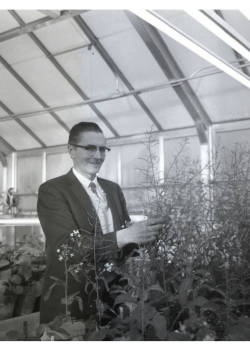
Field of dreams
UM’s gift to the world: Canola
Co-creator Baldur Stefansson's crop innovation is now imported to 50 nations worldwide
Ten years ago UM opened a new space to celebrate exceptional research achievements and on the anniversary of that opening we look back at the inaugural inductee, Baldur Stefansson, the father of one of Canada’s most economically important crops—canola. It is also now exported to 50 countries, worldwide and according to the Canola Council of Canada, it’s grown by 43,000 Canadian farmers who produce about 20 million tonnes of canola every year.
“Canola” refers to a particular group of rapeseed varieties that is in the mustard family, which is why—if you are the type of road trippers to debate such matters—you may find yourself arguing whether a field of yellow flowers you pass by is mustard or canola. They look very similar.

Baldur Stefansson in a UM greenhouse, unknown date, UM Archives & Special Collections
These rapeseed plants are ancient and were long prized in Europe and Asia for the oil content, which was used for lamps and cooking, and even engine lubricant. But they had a problem: they were high in two types of acid that were nutritionally undesirable, and they also had a compound that could alter the flavour of some vegetables.
Stefansson [(BSA/50, MSc/52, PhD/66, LLD/97] began his career as an oilseed breeder in the Department of Plant Science and he saw that there was an opportunity to make this ancient plant better, and able to thrive in temperate climates. He led a team that meticulously crossbred rapeseed varieties and he found a crop that produced excellent food-grade oil without these other compounds.
In 1974 they released Tower, a new rapeseed variety that became known as “Canadian oil” or canola in 1978. By the 1980s, canola had replaced all other rapeseed in Canadian oilseed production. With an entrepreneurs insight, in 1987 Stefansson then registered the world’s first low linolenic canola cultivar, Stellar, and products made with canola have since been commonplace on grocery shelves. Indeed, in 2022 Canada harvested 18.2 million tonnes of it, more than corn’s record-breaking harvest of 14.5 million tonnes, according to Statistics Canada.
Stefansson became an internationally recognized plant breeder, winning the Wolf Prize in Agriculture in 1998, arguably the most prestigious award an agricultural researcher could receive, and was inducted to the Canadian Agricultural Hall of Fame. He was made an officer of the Order of Canada and received the Order of Manitoba. In 1997, he received an honorary doctorate from the University of Manitoba.
A bust of Stefansson was erected in Innovation Plaza in front of the Buller Building in August 2003. His installation was sponsored by the Richardson Foundation, and the sculpture was created by artist Madeleine Vrignon (BFA/1979).






